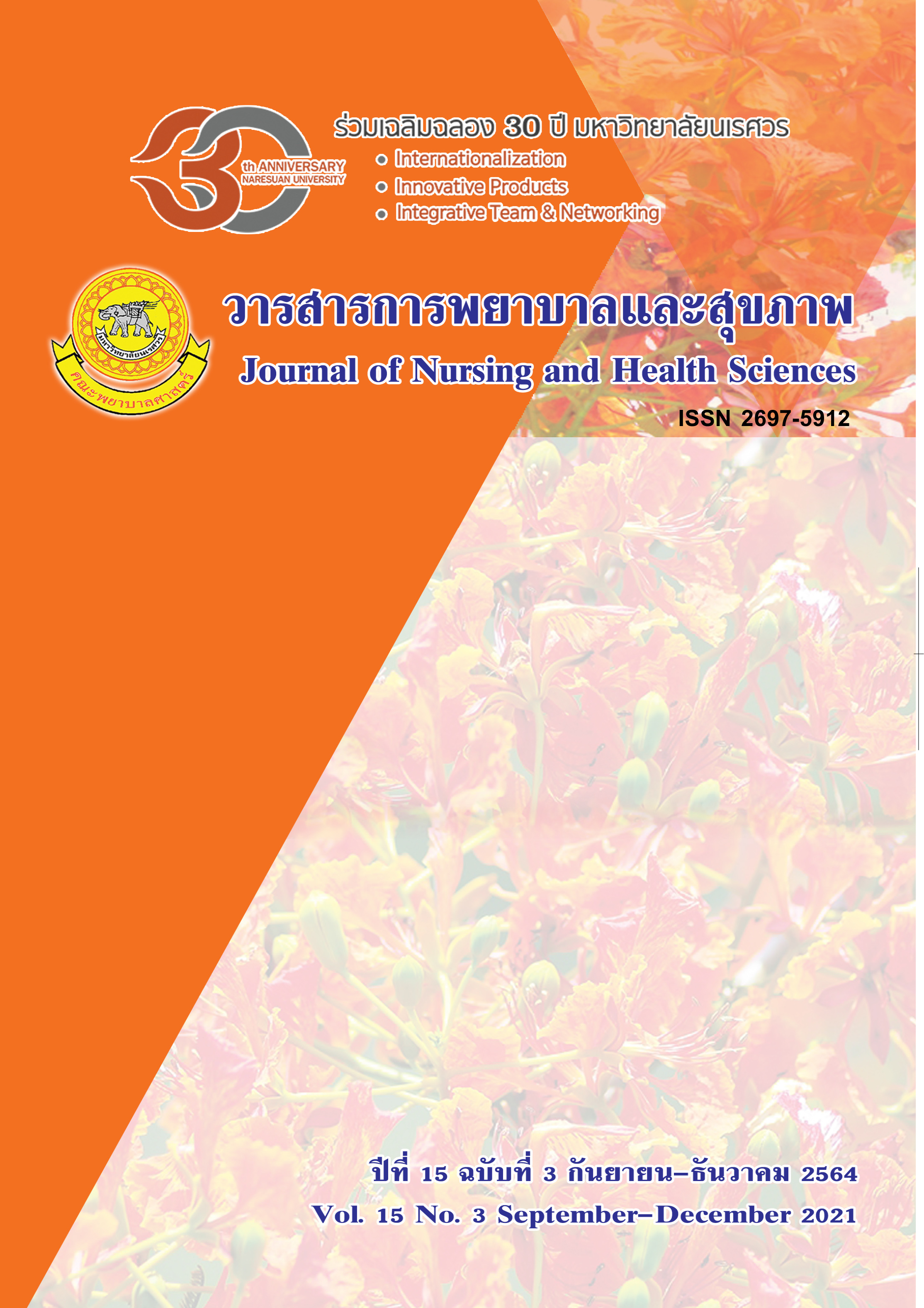ผลของโปรแกรมการโค้ชแบบเพียร์ต่อความสามารถในการปฏิบัติงาน ของพยาบาลวิชาชีพในโรงพยาบาลเอกชน
Main Article Content
บทคัดย่อ
การวิจัยนี้มีวัตถุประสงค์เพื่อศึกษาผลของโปรแกรมการโค้ชแบบเพียร์ต่อความสามารถในการปฏิบัติงานของพยาบาลวิชาชีพในโรงพยาบาลเอกชน เป็นการวิจัยกึ่งทดลองศึกษาแบบก่อนและหลังการทดลอง 2 กลุ่ม ประชากร คือ พยาบาลวิชาชีพที่ปฏิบัติหน้าที่ในแผนกผู้ป่วยใน กลุ่มตัวอย่างจำนวน 60 คน แบ่งเป็นกลุ่มทดลองและกลุ่มควบคุมกลุ่มละ 30 คน เครื่องมือที่ใช้ในการวิจัย ได้แก่ โปรแกรมการโค้ชแบบเพียร์ และแบบสอบถามความสามารถการปฏิบัติงานของพยาบาลวิชาชีพ เครื่องมือผ่านการตรวจสอบดัชนีความเที่ยงตรงเชิงเนื้อหา(content validity index) จากผู้ทรงคุณวุฒิ 5 ท่าน ได้เท่ากับ 0.86 และหาความเชื่อมั่นโดยหาค่าสัมประสิทธิ์แอลฟาของครอนบาค (Alpha's Cronbach) ที่ 0.95 วิเคราะห์ข้อมูลโดยใช้สถิติเชิงพรรณนาและและสถิตเปรียบเทียบค่าเฉลี่ยระหว่างกลุ่มตัวอย่างสองกลุ่มที่เป็นอิสระจากกัน กำหนดระดับนัยสำคัญที่.05 ผลการศึกษาพบว่า ผลการเปรียบเทียบคะแนนความสามารถในการปฏิบัติงานของพยาบาลวิชาชีพของกลุ่มทดลองและกลุ่มควบคุมมีคะแนนความสามารถในการปฏิบัติงานของพยาบาลวิชาชีพก่อนใช้โปรแกรมการโค้ชแบบเพียร์ไม่แตกต่างกันอย่างมีนัยสำคัญทางสถิติ (p > .05) และพบว่าหลังใช้โปรแกรมการโค้ชแบบเพียร์มีคะแนน
ความสามารถในการปฏิบัติงานของพยาบาลวิชาชีพแตกต่างกันอย่างมีนัยสำคัญทางสถิติ (p < .05) และเปรียบเทียบคะแนนความสามารถในการปฏิบัติงานของพยาบาลวิชาชีพของกลุ่มทดลองหลังการใช้โปรแกรมการโค้ชแบบเพียร์มากกว่าก่อนทดลอง และมีความแตกต่างกันอย่างมีนัยสำคัญทางสถิติ (p < .05) ผลการวิจัยชี้ให้เห็นว่าโปรแกรมการโค้ชแบบเพียร์ที่พัฒนาขึ้นสามารถนำไปใช้ในการการพัฒนาความสามารถในการปฏิบัติงานของพยาบาลวิชาชีพที่ปฏิบัติหน้าที่ในแผนกผู้ป่วยในได้
Article Details

อนุญาตภายใต้เงื่อนไข Creative Commons Attribution-NonCommercial-NoDerivatives 4.0 International License.
เอกสารอ้างอิง
Bangkok Christian Hospital NakhonPathom, Nursing
Department. (2019). Self-assessment report.
NakhonPathom: Nursing Department, Bangkok
Christian Hospital NakhonPathom. [In Thai].
Haohan, C., & Inthongpan, O. (2015). A Research and
development of coaching models to enhance
health care service skills. Nursing Journal of
the Ministry of Public Health, 25(1), 167-177.
[In Thai].
Iamsamang, C.(2013). The development of peer
cognitive coaching model to develop coaching
competency and instructional competency
enhancing analytical thinking skill of commercial
college teachers. Doctoral Dissertation (Curriculum and Instruction), Silpakorn University,
Bangkok. [In Thai].
Joyce, B., & Showers, B. (1996). The evolution of peer
coaching.EducationalLeadership Journal 1996.
Retrieved 9 March 2020 from http://www.ascd.
org/publications/educationalleadership/mar96/
vol53/num06/The-Evolution of Peer Coaching.
aspx
Joyce, B., & Showers, B.(2002). Student achievement
through staff development (3rd ed.). Alexandria,
VA: ASCD.
Khamkhum, I. (2015). Effects of coaching on knowledge
and practice of nurses in the prevention of
urinary tract infections in the elderly in long-term
care settings. Master Thesis, Chiang Mai
University, Chiang Mai. [In Thai].
Kunsila, O. (2013). The development of instructional
capabilities of 7th- 9th grade mathematics teachers
by peer coaching. Master Thesis (Curriculum
and Supervision), Silpakorn University, Bangkok.
[In Thai].
Manajuti, P., & Manoonsilp, A. (2016) The development
of peer coaching supervision model for demonstration pre-school teachers Chiangmai Rajabhat
University. Pikhanassan, 12(1), 137-150. [In Thai].
Medland, J. (2009). Coaching as a successful strategy
for advancing new manager competency and
performance. Journal of nurses staff, 25(3),
-147.
Meretoja, R., & Leino-Kilpi, H. (2004). Nurse
competence scale: development and psychometric
testing. Journal of Advanced Nursing, 47(2),
-133.
Ministry of Public Health, Cabinet meeting. (2011).
Healthy lifestyle strategic plan 2011-2020.
Retrieved 9 March 2020 from https://www.ryt9.
com/s/cabt/1104256.
Ministry of Public Health, Office of the Permanent
Secretary, Nursing Division. (1996). Roles and
responsibilities of nursing staff operating in
hospitals (3rdrevised edition). Bangkok: Thammasat
University. [In Thai].
Muangsiri, M. (2006). Factors predicting the ability to
work in hospital nurses under the Ministry of
Defense. Master Thesis (Nursing), Chulalongkorn
University, Bangkok. [In Thai].
Promma, P. (2016). A model for developing coaching
skills of nursing leaders. Doctoral Dissertation,
Rajabhat Rajanagarindra University, Chachoengsao.
[In Thai].
Soongkhan, I. (2019) Trend of medical prosecution
steadily rising. Delve into the health system of
Hfocus news agency. Retrieved 10 January 2019
fromhttps://www.hfocus.org/content/2019/01/
Suksawang, S. (2017). Coaching Skills for executives to
develop potential of their subordinates. Retrieved
January 2020 from https://bit.ly/3d1UxVk.
Thailand Nursing and Midwifery Council. (1997).
Core competencies of first-class nursing and
midwifery practitioners. Retrieved 10 January
Thamaisuk, C. (2015). Peer-to-peer coaching to develop
competency in learning management that
promotes mathematical process skills. Master
Thesis (Course and Supervision), Silpakorn
University, Bangkok. [In Thai].
Thiangcharoen, P. (2012). The effect of using the nursing
mentor model on the performance of new
professional nurses as the head of the nursing
teamMueang Chachoengsao Hospital, Chachoengsao
Province. Master Thesis, Burapha University,
Chonburi. [In Thai].
Wanichbancha, K. (2007). Statistical analysis: statistics
for management and research. (10th ed.). Bangkok:
Chulalongkorn University Printing. [In Thai].
Wichitwanna, S., Angsuchot, S., & Pinyopanuwat R.
(2013). Analysis multilevel: HLM Program
(2nd ed.). Bangkok: Charoendee Mankong
Printing. [In Thai].


